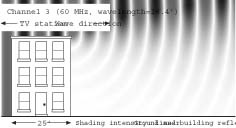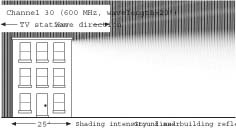Once you've got an antenna, there's as much knowledge involved in mounting it correctly as there was in selecting i. If you don't hire an installer, you're going to need some basic knowledge to get things right.
Once you've got the right antenna [Hack #32] , you've got to put it up. I've separated selection of an antenna from installation, as many folks will allow someone else to take care of installation once the initial purchase has been made. Still, installation and mounting are common tasks, and assuming you understand the possible problems, you're ready to get an antenna set up by yourself.
There is a chance that the first antenna you install won't meet your expectations. Once an outdoor antenna has been installed, the seller won't take it back; even RadioShack won't take back an installed outdoor antenna. The cost of a second antenna might wipe out any savings you hoped for by doing the job yourself. Further, an installer won't charge you for two antennas if he is wrong on the first try.
If you aren't a do-it-yourself type, you can find an installer in the Yellow Pages under "Antennas" (or possibly "TelevisionsâDealers and Services"). The cost ranges from $100 for an easy install to $800 for a difficult install, with $300 being the most typical bill. If you do it yourself, you will pay almost $200 just for the hardware:
Antenna: $70
Amplifier: $70
50 feet of RG-6: $30
You might be able to get some free advice or a free rough estimate over the phone or by visiting the installer's shop. If he comes to your home, the estimate won't be free, but it will be accurate.
And, it would be irresponsible to not mention the following:
There are places within the station's broadcast radius where reception isn't possible, no matter how good your installation is.
There are places where reception is so difficult that the challenge can outwit the installer.
Although the dollar cost of an antenna system is modest, a lot of your time might be required.
With all that said, if you're willing to be careful, patient, and diligent, it's fun and inexpensive to install an antenna. So, take these warnings seriously, but don't let them scare you off.
Once you've got these terms and concepts down, your first step in erecting an antenna is to choose a site to mount the antenna. There are several considerations; here's the rundown.
Diffraction is the ability of a wave to bend around into the shadow formed by an obstruction. It doesn't matter if it is an absorbing or reflecting obstruction. Most OTA viewers depend on diffraction for their reception. The only exceptions are:
Where the transmitting tower can be seen.
Sometimes in cities with tall buildings, reflection is more effective than diffraction.
Low frequencies diffract efficiently, but VHF diffracts poorly (see Figure 4-23).
UHF is another 10 times worse (see Figure 4-24).
Tip
These diagrams use linear shading and thus are perhaps overly pessimistic. Reception might be possible where these diagrams show no signal. Logarithmic shading would convey more optimism.
To make up for the poor performance of UHF, the FCC allows UHF stations to broadcast a much stronger signal, as Table 4-5 shows.
Table 4-5. TV transmitting power allowed by the FCC
|
Channels |
Flat region |
Hilly region |
|---|---|---|
|
2â6 |
50 kilowatts |
150 kilowatts |
|
7â13 |
150 kilowatts |
500 kilowatts |
|
14â69 |
500 kilowatts |
1.5 megawatts |
Tip
The numbers in Table 4-5 are approximate. Stations often argue for and get a higher limit. But the goal in most cases is a 60-mile reception radius
If the antenna is behind a tree, it is in overlapping fields: a weak field that passes through the tree plus a weak field that is diffracted around the tree. Overlapping fields are complicated, with strong spots and weak spots. If you get a UHF antenna to work behind a tree, you likely will see dropouts when the wind blows because the strong and weak spots will move around.
Many people install antennas in the winter and think they were successful. Then in the summer they wonder why the antenna totally quit working. It's the trees!
For VHF, higher is always better. An antenna should be four wave lengths above the ground to be unaffected by the ground. For channel 3, this would be 70 feet (see Table 4-2 to check the wave length for each channel). Of course, for most houses, 70 feet is unreachable.
The rules for UHF are a little more complicated than for VHF, though. UHF is affected more by obstructions and less by height. For UHF, four wave lengths is only about seven feet. However, a UHF antenna should be higher than this in the following cases:
If at all possible, get the antenna above any obstructions.
If your horizon is less than 200 yards away, raising the antenna makes a significant difference. (You would be a candidate for a tower.)
As Figure 4-25 showed, even if you can see the transmitting tower, if the signal skims over the top of some obstructions, there is a stronger field just a few feet higher.
You probably will want to attach a VHF antenna to your chimney. That is also likely the best place for a UHF antenna. But if your chimney mount is still obstructed (by trees, etc.), an unobstructed site closer to the ground will work better for UHF. The essential goal is to find a spot where your UHF antenna can see the horizon in the direction of the station (see Figure 4-25).
Keeping the antenna above four wave lengths minimizes the effect of the ground reflection. Actually, the ground-reflected signal could either add to or subtract from the direct signal, so being close to the ground is not always a disadvantage. I've seen a situation where the strongest UHF signal was found 3 feet off the ground.
Diffraction over the horizon ridge often results in overlapping fields. Overlapping fields will result in weak signal spots (cold spots) and strong spots (hot spots), arranged in a regular pattern. For UHF, the hot and cold spots are often 5 to 20 feet apart.
If you are in a neighborhood with overlapping fields, moving your antenna a few feet can make a huge difference in signal strength. The chimney might seem like the perfect site, but if the chimney is in a cold spot it's a mistake.
To make matters worse, the pattern of hot and cold spots are different for different frequencies. You will want to find a spot that is hot for all the channels you want, but such a spot might not exist above your roof. In this case you need an antenna with higher gain than is otherwise recommended.
To make matters even worse, you likely won't discover that you are in such a neighborhood until after you have purchased and installed the antenna. To prove that you have hot and cold spots, you move the antenna (forward and backward, left and right, higher and lower) while keeping it perfectly pointed at the signal and watching the DTV signal strength indicator. It is hard to keep a large antenna pointed correctly while devoting half of your attention to not falling off the roof, but a smaller antenna might not achieve a digital lock.
At this point a professional installer starts to look like the smart choice. But will he stick with it, or will he, too, quickly declare further improvements impossible and walk away? He will hesitate to raise his estimate, but he will not work at a loss.
These problems are all UHF problems. VHF does the same thing, but with hot and cold spots 50 to 200 feet apart they aren't evident and there usually isn't much you can do about them.
If an indoor antenna isn't as reliable as you want, an attic antenna is the next step up. If you are in a neighborhood with moderately strong signals, an attic antenna might work. But you are wasting your time installing an attic antenna in a poor-signal neighborhood. Most successful attic antennas are within 20 miles of the transmitter.
The problems with attic antennas are:
Estimating the signal loss in ordinary construction materials requires knowledge of their water content. Exceptions are aluminum siding, stucco (which has an embedded metal screen), and foil-backed insulation, all of which totally block all signals. Concrete and most bricks have moderate water content, but their thickness is enough to block all signals. In a desert, plywood becomes so dry that it causes no signal loss at all, even for UHF. In any other place, there will be some moisture. Exterior wood is generally always wet inside, especially in north-facing surfaces. The amount of water varies with the weather. Asphalt shingles are mostly transparent to UHF, but the way they overlap encourages water to persist between them. The vapor barrier is often wet on one side or the other. The bottom line is that there is no way to quantify the signal loss in these materials.
Metals reflect signals. A metal object eight inches long is big enough to reflect UHF. Smaller objects, such as nails, are of no concern. Wires and metal pipes effectively reflect VHF, as do plastic pipes containing water. If these reflecting objects are positioned to the side, to the rear, above, or below the antenna, they will have little effect on it, provided they aren't too close. These objects should be further away than two feet for UHF, four feet for VHF-high, or six feet for VHF-low, and an even larger separation can help a little.
Tip
You might wonder why these numbers aren't proportional to the wave length. It is because the lower-frequency antennas are lower in gain. An antenna's aperture depends on the gain as well as the wave length.
There should be no horizontal or diagonal wires or pipes in front of the antenna. A perfectly vertical metal vent pipe is invisible to TV signals, but its flashing at the roofline might not be.
âKenneth L. Nist
Get Home Theater Hacks now with the O’Reilly learning platform.
O’Reilly members experience books, live events, courses curated by job role, and more from O’Reilly and nearly 200 top publishers.




